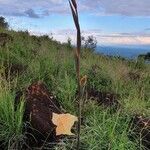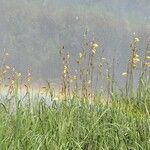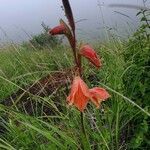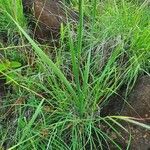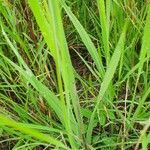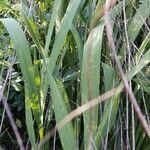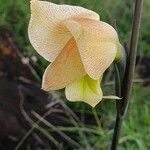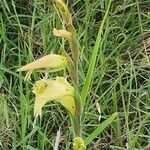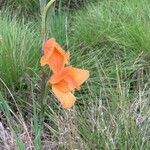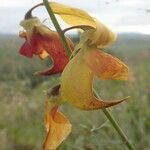Plants (50-)70-120(-200) cm. high.. Corm (1.5-)2-3 cm. in diameter, tunics of brittle, coriaceous to membranous layers, the outer becoming irregularly broken, sometimes fibrous, reddish brown, usually bearing numerous tiny cormlets around the base.. Foliage leaves either contemporary with the flowers (subsp dalenii ) or produced after flowering (subsp andongensis ), then foliage leaves produced on separate shoots after flowering.. Stem unbranched.. Spike erect, (2-)4-7(-14)-flowered; bracts green, sometimes dry and pale apically, (2.5-)4-7 cm. long, the inner slightly shorter than the outer.. Flowers either red to orange with a yellow mark on each of the 3 lower tepals or yellow to greenish and often with red to brown streaks on the dorsal tepals; perianth-tube (2.5-)3.5-4.5 cm. long, nearly cylindric and curving outward above; tepals unequal, the 3 upper broadly elliptic-obovate, the dorsal 3.5-5.5 × 2.2-3.5 cm., largest, horizontal to down-curved and concealing the stamens, the upper laterals ± as long to ± 5 mm. shorter than the dorsal, 2-3 cm. wide, directed forwards, often curving outward distally, the lower 3 tepals 20-25(-30) × 8-12 mm., curving downwards, the lowermost somewhat longer and narrower than the lower laterals.. Filaments ± 2.5 cm. long, exserted 1.5-1.8 cm.; anthers 1.2-1.6 cm. long, pale yellow.. Style dividing near or beyond the anther-apices, branches (4-)5-6 mm. long.. Capsules ± obovoid, (1.8-)2.5-3.5 cm. long.. Fig. 16/1-2.
Foliage leaves either synanthus and produced simultaneously with the flowers on the flowering shoot (subsp. dalenii) or hysteranthus and produced after flowering on separate shoots from the same corm (subsp. andongensis); synanthus foliage leaves 4–6(7), at least the lower 2 basal or nearly so, long-laminate and about half as long as the spike, (5)10–20(30) mm wide, narrowly lanceolate to nearly linear, firm textured with moderately raised thickened midribs and margins, the upper 1–2 leaves (of plants with synanthous leaves) cauline and sheathing for at least half their length, sometimes entirely sheathing, often imbricate; hysteranthus foliage leaves usually only 2 and resembling basal synanthus foliage leaves, flowering stem leaves (of plants with hysteranthus leaves) entirely sheathing or with blades up to 6 cm long.
Perennial herb, geophyte, 0.35-1.60 m high; corm with reddish brown tunics; stem simple. Leaves 4-6(7), lanceolate, (5-)10-30(-70) mm wide; foliage leaves synanthous, often imbricate (produced simultaneously with flowers. Bracts pale green to grey-purple adaxially. Inflorescence a 3-8-flowered spike, erect; flowers either red to orange with yellow marks on 3 lower tepals or yellow to greenish with red to brown streaks on upper tepals; perianth tube cylindric, widening and curving outward above; tepals unequal, the upper 3 elliptic-obovate, dorsal largest, horizontal to down-curved. Stamens exserted; anthers yellow to brownish; pollen pale yellow. Ovary oblong; style arched over stamens, branches broadened above. Flowering time Nov.-May. Capsule ellipsoid to ovoid, apically 3-lobed.
Flowers either red to orange with a yellow mark on each of the 3 lower tepals, or flowers yellow to greenish and often with red to brown streaks on the upper tepals; perianth tube (25)35–45 mm long, nearly cylindric and curving outward in the upper half; tepals unequal, the 3 upper tepals 35–50 × 22–30 mm and broadly elliptic-obovate, the uppermost larger than the others and horizontal to down-curved concealing the stamens, the upper lateral tepals about as long as, to c. 5 mm shorter than, the uppermost, 20–30 mm wide and directed forwards often curving outward distally, the lower 3 tepals 20–25(30) × 8–12 mm and curving downwards, the lowermost somewhat longer and narrower than the lower lateral tepals.
Its uses in treating cases of diarrhoea and as a cold remedy are also documented (fide Watt & Breyer-Brandwijk, 1962; Jacot-Guillarmod, 1971).There are records that, at least in West Africa, G.dalenii is cultivated on farms in the forest, where it was introduced from the savanna country to the north (fide Dalziel, 1937).
Gladiolus dalenii is easily recognised by the large flowers, 60–80 mm long with the upper 3 tepals 35–50 mm long and much exceeding the downcurved lower tepals, as well as the strongly hooded uppermost tepal, the well exserted anthers and the fairly long perianth tube which slightly exceeds the long floral bracts.
A herb. It grows up to 90 cm high. The leaves are near the base and long and narrow. The leaves are 2 cm wide. The flowers are on stalks about as high as the leaves. The flowers are usually turned to one side. They are yellow with reddish dots. The flower tube is 3 cm long. The fruit is an oblong capsule.
More important than its value as a wild species in garden displays, is the role of G.dalenii as one of the parents in the original crosses that led to the development of the large-flowered Gladiolus hybrids which today are one of the worlds most important cut-flower crops.
Almost throughout its range, Gladiolus dalenii occurs in populations with flowers either pale-yellow (G. primulinus) to greenish with or without red to brown streaking, or flowers orange to red with bright-yellow and sometimes green markings on the lower tepals.
Corms (15)20–30 mm in diameter; tunics reddish-brown, of brittle or coriaceous to membranous layers, the outer becoming irregularly broken, sometimes fibrous; numerous tiny cormlets usually present around the base.
Robinson 5471, with 2–3 foliage leaves and short spikes of 2–3 flowers, fit awkwardly in G.dalenii, as do a few collections from Malawi with purple flowers (la Croix 287, Richards 14462).
Cormous herb, up to 1.5 m high. Perianth with the 3 lower lobes recurved and smaller than upper hooded lobes. Perianth tube shorter or about as long as upper lobe, lobes well-developed.
It is widespread in sub-Saharan Africa and Madagascar and common throughout the Flora Zambesiaca region except for the semi-arid to arid pans of Botswana and southern Zimbabwe.
It is used in parts of West and southern Africa in preparations to cure both constipation and severe dysentery, and is highly esteemed in curing snake-bites’ (fide Irvine).
Spike (2)3–7(14)-flowered, erect; bracts green, sometimes dry and pale apically, (2.5)4–7 cm long, the inner slightly shorter than the outer.
Elsewhere in tropical Africa the Corms maybe eaten; the starchy Corms are boiled and then leached in water before they are eaten.
In southern Africa G. dalenii (under several synonyms) is a common component of the herbalist’s medicine horn (lenaka).
A late summer-flowering form from southern Africa with scarlet flowers is perhaps the best known to horticulture.
How much of its remarkably wide distribution is due to deliberate human activity may never be known.
G.dalenii is also one of the few species of Gladiolus useful to man other than as an ornamental.
Too little is known about the latter series of populations, always found in wetlands.
Style dividing near or beyond the anther apices, style branches (4)5–6 mm long.
Filaments c. 25 mm long, exserted 15–18 mm; anthers 12–16 mm long, pale-yellow.
They may on further investigation be found to warrant taxonomic recognition.
Shorter tubed yellow-flowered populations from western Zambia, eg.
It occurs in grasslands and woodlands and occasionally in dambos.
It is a striking ornamental plant, now widely cultivated.
The foliage leaves are typically broad and sword-shaped.
Capsules (18)25–35 mm long, ellipsoid to ovoid.
Plants (50)70–120(150) cm high.
Stem unbranched.
